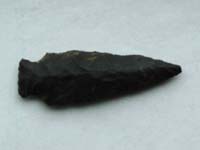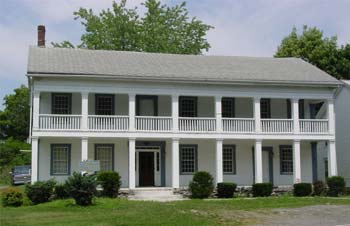| HOME | OUR TOWN | CONCERNS | EVENTS | PRESS | HISTORY | LINKS | CONTACT US |
 |
History It is the foundation of our future |
 |
Early inhabitants
Artifacts found in Milan indicate the earliest inhabitants were Native American Mohicans living here around 3,000 years ago. Although the "Indian cemetery" marked by the NY State tourism industry in 1925 on Turkey Hill Road is of doubtful origin, for years farmers plowing their fields in Milan have found authentic arrowheads ( shown on left) and other remnants of that early society. European settlement of the area happened much more recently. |
European "discovery" from 1609
Henry Hudson famously moored his ship the "Half Moon" due west of Milan on the East bank of the Hudson River at what is now Red Hook on September 15, 1609.
But the English took over from the Dutch in this area in 1664 and by 1683 the province of New York was divided into twelve counties including Dutchess County (so named for the wife of the then-Duke of York and future King James II).
Although the "Little Nine Partner Patent" was granted in 1706 and included what are now the towns of Milan, Pine Plains and Northeast, virtually no Europeans were living in the area at that time. First European setters in Milan in 1760 near Wilcox Memorial Hall
760 near Wilcox Memorial Hall
Johannes Rowe (Rau) was the first major landowning resident. He purchased 911 acres in 1760 and built a stone house (since demolished) on what is now called Rowe Road near Wilcox Memorial Hall. Johannes Rowe helped establish one of the town's first churches, a Methodist church in 1800. "Rowe United Methodist Church," a subsequent building, stands across from Wilcox Memorial Hall on the south side of Route 199. |
 |
 |
Formation of Milan in 1818 The Town never had a single center, but rather had a series of small hamlets that were at their peak of activity by the 1840's. Near each other on Salisbury Turnpike in the southern part of Town were two hamlets: "Thorndale," named for Stephen Thorne, the first Town Supervisor who lived nearby at Field Road. "Milanville" (now Cases Corner) which had a post office and small businesses, many of the buildings remain today at Milan Hollow Road |
Further east, Lafayettville, most likely named after the Marquis de LaFayette who visited the nearby Livingstons in 1824, had a hotel and was a major stop on the stagecoach route. Rock City, in the Southwest corner of town, had a saw and grist-mill, hotel, post office, blacksmith and shoe shop. Several old buildings remain. Jackson Corners in the northeast part of town had a post office, grist mill, blacksmith. Shookville, on the western border with Red Hook still has the ruins of its church and the Shook family cemetery. |
 |
How and why Milan avoided major development and retained its rural character.
Just as Milan was gearing up with its six hamlets as a busy agricultural town in the 1840's, the railroad boom, the boom in the western US, and the migration to New York industrial cities like Oneida, Plattsburg and Glens Falls took their toll on Milan. Although in hindsight, this exodus was a blessing because it kept major development from over-running the town.
While "river towns" like Poughkeepsie continued to have sharp population growth, the "in-land" towns like Milan had a reversal.
At it's agricultural hey-day in 1840 the population of Milan was 1,725. By 1870 the population was down to 1,474. But by 1930 this had declined to 622.
The 1840 population would not be reached again until the 1980's.
Milan's main roads run from Southwest to Northeast reflecting the town's 18th century's role of being a byway between the ships of the Hudson River and New England industry.
Parts of Turkey Hill Road (formerly Salisbury Road as in Salisbury, Connecticut) in the north of town and Salisbury Turnpike in the south of the Town are examples of this.
The location of Milan "between two places" and the towns distribution among hamlets helped avoid the kind of commercial development and sprawl many towns have today.
The major north-south exception to this is, of course, the Taconic State Parkway, a pet project of then-governor Franklin D. Roosevelt in the 1920's which has two major exit/entrances. A factor in Milan's recent growth, it will play a large role in its future growth. It is the location of Milan's only gas station.
The Wilcox's: A Park, a Town Hall, and a Trust
Frederick Wilcox came to Milan in 1909 and purchased the first of several farms, marrying Irene Kilmer, a Milan resident. After her husband's death in 1942 and the death of their son in a plane crash in 1950, she sold 620 acres of their farm in 1961 to Dutchess County for what we know as "Wilcox Park" in the southeast part of town.
With the proceeds from that sale she established Wilcox Memorial Hall in 1966 as a "gift to the town of Milan as a memorial to my husband and son. It will be open to everyone at all times to be used as a Town Hall and for meetings and dinners."
Before her death in 1977 Mrs. Wilcox also set up trust funds which help defray Town expenses to this day and keep taxes low.
21st century
Milan, the smallest town in Dutchess County, is the second-fastest growing. Circumstances have allowed Milan to avoid a great deal of the excessive types of development seen elsewhere. But in two generations we've seen Milan's population quadruple in size. Planning for Milan's future with a view and understanding of it's past can help us make the right decisions.
References History of Dutchess County, by James H. Smith, Syracuse, 1882 |
Links
Dutchess County Genealogical Society
Historic American Buildings Survey - Milan